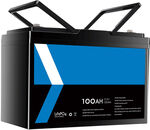Back Again! - this deal is back but APR17 code now with eBay plus
12V 100Ah Lithium Iron Phosphate Battery LiFePO4 Rechargeable Camping RV
These have pouch cells and are usually sold as 'Gentrax' brand.
Members who bought the 200Ah from the same brand are currently testing this with promising results https://www.ozbargain.com.au/comment/15146180/redir
The final price is $248.38 with code + free shipping
200Ah version also avail available $509.36 with APR15 ($497.38 with APR17 and eBay Plus) https://www.ebay.com.au/itm/126056610992
NOTE - discount is automatically applied in checkout.
Dont forget to use your favourite Cashback company and please share your thoughts if you bought this last time.






Good deal. Just to answer the FAQ.
I'll be happy if it lasts me 4 years.